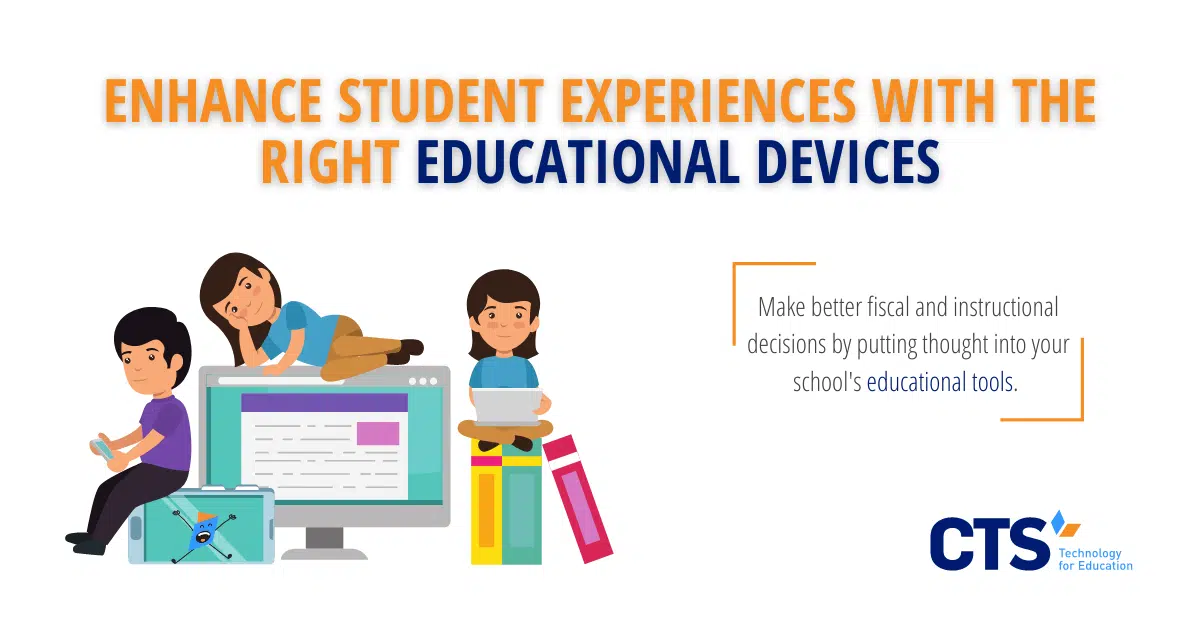Selecting the right school devices can add significant value to instructional content.
No matter their instructional model, schools can greatly benefit from the use and integration of school technology into their day-to-day practice. Whether it’s using an instructional platform that differentiates content for students in real-time or a Chromebook that allows a student to access their schoolwork remotely, school devices can build upon traditional pedagogical methods to truly enhance students’ educational experience.
At CTS, we believe that with the right tools, anything is possible.
Our team has worked with more than 60 partners across the United States. Whether new schools, schools undergoing an expansion, or more established schools that simply want to enhance their existing technology programming, we help guide teams through the educational technology market. Rather than returning to the same list of products for each client, we work with school leaders to understand their instructional model, identify their roadmap for achieving institutional goals, and make recommendations based on our findings. Contact us today to learn more about how we can help you make the most of your school devices.
Rather than isolated choices, think of each device selection within the context of your broader educational technology program.
Before clicking “submit order” on any school devices, school leaders should think critically about how all of their potential purchases will integrate with one another. Operating systems are an obvious example. While it’s certainly possible–and, in some cases, may be optimal, depending on the school’s model–to purchase student and staff devices with different operating systems, school leaders should think through how such differentiation might impact the user experience. For example, will all of the school’s instructional platforms function effectively across the different operating systems? School devices don’t exist in a vacuum. School leaders’ decision-making process should, therefore, optimize for choices that support integration with their broader school technology program.
For Chromebooks, select a student-device ratio based on both your instructional model and cost.
Students increasingly make daily use of Chromebooks, whether accessing an online instructional platform, using Google classroom, or, more traditionally, conducting research for a particular course. Determining whether a 1:1 student-device ratio makes sense for a school comes down to both cost and the school’s unique instructional model. Purchasing a device for every student can be expensive, particularly for new schools, but if the school has a STEM focus or places its emphasis on technology programming, the school may have little choice but to embrace a one-to-one environment.
Adults deserve great devices too. Choose staff laptops that prioritize the user experience.
For staff devices, schools should consider the quality of the user experience for each of their options. Teachers have enough on their plates as it is, so selecting a device model that is easy to use, reliable, and, when problems do arise, simple to troubleshoot, can alleviate the headaches that sometimes occur with school devices. Here, again, schools should consider the ways in which their staff devices integrate with their school’s more general educational technology ecosystem.
Finally, for both student and staff devices, establishing robust, consistent tracking systems is critical to maintaining inventory quality. Schools should work with their technology services provider to establish a shared device-tracking source in which all device statuses are housed. Doing so early in the school year can save valuable time when determining purchasing priorities in the spring.
Leverage E-rate funds to cover the costs of your school devices.
E-rate funds can allow schools to offset the significant costs associated with their student, staff, and supplementary devices. When crafting the school’s bid each year, leaders should take the time to inventory their existing technology and, importantly, forecast their educational technology needs over the coming years. New switches and cables can be expensive, so planning ahead for these and other big-ticket purchases can allow the school to avoid unexpected service outages or systemic issues that could compromise classroom instruction.
By taking the time to thoughtfully evaluate their school device choices, school leaders can make better fiscal and instructional decisions, maximizing the impact of each dollar on teacher practice and, ultimately, student achievement.




